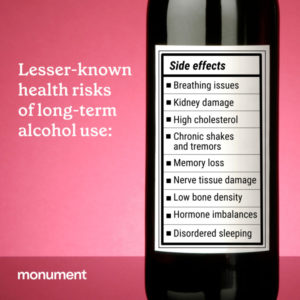Although over 85% of Americans have tried alcohol at least once in their lifetime, most people aren’t aware of how ‘getting drunk’ actually works.¹ They might know the feeling of being drunk, but they don’t understand how alcohol interacts with the body and ultimately leads to buzzing or drunkenness. To clarify this subject, we’re going to discuss how alcohol makes you drunk, and the different factors that impact drunkenness.
Why Does Alcohol Make You Drunk
If someone asked you what causes drunkenness, you would likely answer that it was obviously alcohol. While that’s correct, the most accurate answer is even more specific. Yes, it’s the alcohol, but more particularly, it’s the ethanol in the alcohol that leaves you feeling drunk and hungover.
Ethanol’s Effects on the Brain
Ethanol is a byproduct produced from fermentation, which is just a fancy way of saying it’s made when grains and other products begin to break down.² The amount of ethanol in each alcoholic drink is measured by its ABV (alcohol by volume), for example wine has an average ABV of 11%, whereas whiskey has an average ABV of 40%. Consuming ethanol, even in small amounts, has a direct effect on the brain.
Our brain is filled with neurons that transmit information. These neurons communicate via neurotransmitters, and these neurotransmitters can have negative interactions with ethanol. For example, ethanol binds to the GABA receptors in the brain, slowing down their ability to communicate with one another.³ As a result, you often feel sleepy after drinking. Ethanol also acts on the NMDA receptors, hindering short-term memory formation, motor skills, cognition, and more.⁴ These short-term impairments combine to form the sensation of being “drunk.”
Long-term exposure to ethanol can pose an even greater threat to the brain’s functioning. Ethanol is highly toxic in large quantities, and can begin to kill off neurons. Continuous consumption can cause the brain to shrink, especially near the frontal lobe, which is responsible for memory, emotions, problem-solving, and more. This can result in blackouts and other serious consequences.
Simply put, ethanol disrupts the functioning of neurotransmitters and ultimately changes your brain chemistry. Sometimes these changes are temporary, but other times the effects are irreversible.

What Factors Impact Drunkenness?
Alcohol doesn’t impact everyone in the same way or at the same time. For example, one person may feel drunk after two glasses of wine with dinner, whereas another person may only feel drunk after multiple rounds of shots. This happens because different factors play into drunkenness. Some of those factors include:
Gender
Women are impacted by alcohol differently than men, primarily due to their weight and body chemistry. In general, women weigh less than men, and weight affects how alcohol is metabolized. In addition, women typically have lower alcohol dehydrogenase levels, which is an enzyme that helps break down alcohol. Therefore, if a woman drinks the same amount of alcohol as a man, her blood alcohol level will probably be higher than his due to how her body processes it, and she’ll likely feel drunker than him.
Mood
How you feel before you start drinking may impact how drunk you feel later. For example, if you’re experiencing high levels of stress, your body may absorb alcohol more quickly and heighten the existing stress levels. This is because your mood can change the enzymes in your stomach, affecting how alcohol is processed.⁵ Additionally, consuming alcohol can worsen pre-existing feelings of depression or anxiety.
What You Drink
There’s a common misconception that being drunk on one type of alcohol is different than being drunk on another type of alcohol, but this isn’t true. There’s no such thing as being “wine drunk” or “beer drunk” because all alcoholic beverages share the same active ingredient: ethanol. However, the percentage of alcohol in your beverage is a factor in how drunk you will feel, and how quickly. For instance, a 12 ounce can of beer is approximately 5% alcohol, but a 1.5 ounce shot of rum, gin, or tequila will contain about 40% alcohol.⁶ Beverages that contain higher alcohol content can cause you to feel buzzed or drunk much more quickly, especially if you’re drinking them in quick succession (known as binge-drinking).
Other Medications and Illnesses
Sometimes people feel more drunk depending on how well their immune system is or isn’t working. For instance, if a person is exhausted or coming down with a cold or the flu, they may feel more drunk than usual, even if they’ve only had one beer or a glass of wine.
In addition, some medications can ramp up the effect of alcohol and cause you to feel tipsier than you otherwise would. Certain medications should never be mixed with alcohol, such as anti-depressants and narcotics. This can lead to dangerous and even life-threatening side effects. Speaking with your healthcare provider and following prescription guidelines is the best way to ensure your safety.
Food
When people drink on an empty stomach, the alcohol moves more quickly from the stomach to the small intestines, where it’s then absorbed into the bloodstream. As a result, not only does the alcohol reach the blood much faster, but one experiences a rapid rise in their blood alcohol level. Ultimately, this means the individual will feel drunker much more quickly, which can be extremely dangerous.
If one eats before they drink, the food will slow down the absorption of alcohol into the bloodstream. This can reduce the feelings of drunkenness and/or delay its impact.

The Short-Term Effects of Consuming Alcohol
There are numerous possible short-term effects of drinking alcohol, many of which depend on the amount of alcohol consumed.
Mood Changes
If you’re drinking in moderation, you may experience a short-term improvement in your mood after one to two drinks. Because alcohol can initially release pleasure hormones in the brain, might take the edge off social anxiety and leave you feeling more relaxed. This is why many people develop a “chemical romance” with alcohol. However, alcohol is a depressant, and can cause anxiety or depression to worsen after its initial effects wear off. As you consume more and more alcohol, you may feel your mood worsening and your anxiety skyrocketing.
Overall, short-term mood changes vary from individual to individual. In fact, it may even be different for the same person depending on other things that are happening in their life.
The Impact of Alcohol on the Central Nervous System
As a depressant, alcohol slows down the central nervous system. That’s why drinking alcohol can make you feel groggy, and cause you to struggle with answering complex questions. This feeling of grogginess is likely to increase the more you have to drink. Alcohol also slows down your motor planning and movement, which is why many people feel clumsy when they’re drunk. It’s also why it’s so dangerous to drive after you have been drinking.
In addition to slowing down reflexes and impacting fine and gross motor skills, as people drink more, they may find it hard to speak. Slurred speech is a commonly reported side effect of heavy drinking.
Another common effect of drinking too much is an upset stomach, leading to nausea, vomiting, and diarrhea. This is more likely to happen if someone has been drinking a lot or if they are drinking on an empty stomach.
The Long-Term Effects of Drinking Alcohol
There are many long-term side effects of alcohol use. This is largely shaped by how much you drink and how frequently you drink.
Two of the organs most affected by unhealthy alcohol use are the liver and the brain. In very severe cases, alcohol consumption can lead to cirrhosis of the liver, which may necessitate a liver transplant and, in some cases, can lead to death. In the brain, alcohol is toxic to neurons, and can affect long-term cognitive processing.
While you likely hear the most about alcohol and the liver, alcohol can affect organs throughout the body. Alcohol consumption may also increase the risk of a wide range of digestive system cancers, and lead to cardiac diseases, including both arrhythmias and myopathies, as well as peripheral neuropathy.⁷

If you’re concerned about the long-term risks of drinking, that’s a sign it’s worth taking a closer look at your relationship with alcohol. At Monument, we offer tools to help you create healthier drinking habits, including alcohol therapy, medication to stop drinking, and peer support. The body is capable of healing in incredible ways, and many of these long-term effects can be prevented or minimized by cutting back or cutting out alcohol.
How Does Alcohol Travel Through The Body
From the time you take a sip of alcohol to when it exits your body, it passes through and impacts many vital organs. Here’s how alcohol affects some of your organs as it makes its journey through your body.
Mouth
Our mouths are the entryway for alcohol into our bodies and bloodstreams. One interesting thing that many people don’t know is that at least some of the alcohol we put into our body immediately enters the bloodstream in our mouth because our mouth and tongue are rich in blood vessels. Alcohol’s contact with the mouth can contribute to various consequences such as gum disease and mouth decay.
Stomach
The stomach is key to the metabolization of alcohol. Just like our mouth, our stomach has a lot of blood vessels. This means that it’s easy for alcohol to move from our stomach directly into our bloodstream. Almost 20% of alcohol enters our blood through this mechanism.
The faster alcohol enters our bloodstream, the more likely we are to feel buzzed or drunk. Many factors influence how fast alcohol absorption will happen in our stomach. As mentioned above, the most important one is if our stomach is empty or full.
Small Intestine
The small intestine is another place where alcohol enters your bloodstream, because of all the blood vessels there. How much of the alcohol enters here versus how much enters through your stomach will depend on a variety of factors, such as how full your stomach is. The interaction between alcohol and the small intestine can lead to various gut-health issues, such as inflammation and an overgrowth of ‘bad bacteria’.
Bloodstream
Alcohol enters your bloodstream through blood vessels found throughout your digestive system, including in the mouth, stomach, and intestines. Once alcohol enters your bloodstream, it’s moved to all of your organs, including your heart, brain, and kidneys.
In the bloodstream, alcohol acts as a vasodilator, which means it increases the size of your blood vessels. As a result, more blood is sent to your organs and your skin. This is why many people get a red face or feel flushed when drinking alcohol.
Brain/Nervous System
Even though alcohol is a depressant, in the short term, you’re likely to feel a surge in your mood from drinking since alcohol spurs the release of serotonin and dopamine. Both of these hormones are mood elevators.
However, alcohol ultimately interferes with how the neurotransmitters in your brain operate, disrupting your brain chemistry. This can leave you feeling lethargic and sleepy. It can also mess with your reflexes, leaving you feeling clumsy and with slurred speech.
Lungs
We often don’t think about our lungs when we think about how alcohol affects our different organs. But, our lungs do play an important role in the metabolism of alcohol. Surprisingly, after a period of time, alcohol moves out of the bloodstream and back into the lungs. From there, we exhale it out of our body through our mouth.
Kidneys
You may have wondered why you have to visit the restroom a lot more when you’ve been drinking. There is a scientific answer to this conundrum. Alcohol negatively affects one of the hormones in our brain that determines our urine production. Without this hormone working appropriately, our body suddenly decides that it needs to produce more urine. This is definitely inconvenient, but it can also be dangerous. If you are not replacing what you pee out, you may become dehydrated after a night on the town. Dehydration, in turn, can make you feel drunker, and it can also dramatically worsen a hangover or hangxiety.
Liver
The liver is the key organ in your body that oxidizes and breaks down alcohol. But, even though your liver is an amazing organ, there is only so much work that it can do in a given time. Usually, this means processing about one drink per hour. Anything more than that leaves your liver struggling to keep up, and means that alcohol will sit in your bloodstream, and your blood alcohol levels will remain elevated.
Many people drink alcohol because they’re looking for the feeling that it brings, but don’t know how it actually works. Here at Monument, we understand that alcohol can be a complicated and emotionally-charged issue for many people. Therefore, we like to provide people with tools, such as education, alcohol therapy, or medication to stop drinking so that they’re comfortable either abstaining from drinking or drinking in moderation.
Sources:
- National Institute on Alcohol Abuse and Alcoholism. “Alcohol Facts and Statistics, https://www.niaaa.nih.gov/publications/brochures-and-fact-sheets/alcohol-facts-and-statistics#:~:text=Prevalence%20of%20Drinking%3A%20According%20to,in%20this%20age%20group%20and.” Accessed Apr, 21. 2022.
- ChemicalSafetyFacts.org. “Ethanol Uses, Benefits, and Chemical Safety Facts, https://www.chemicalsafetyfacts.org/ethanol/.” Accessed Apr, 21. 2022.
- BioMed Central “Role of Gabaa Receptors in Alcohol Use Disorders Suggested by Chronic Intermittent Ethanol (CIE) Rodent Model – Molecular Brain, https://molecularbrain.biomedcentral.com/articles/10.1186/s13041-017-0325-8.” Accessed Apr, 21. 2022.
- Frontiers in molecular neuroscience vol. 6 14. 28. “Alcohol and NMDA receptor: current research and future direction, https://pubmed.ncbi.nlm.nih.gov/23754976/.” Accessed Apr, 21. 2022.
- University of Notre Dame. “Absorption Rate Factors, https://mcwell.nd.edu/your-well-being/physical-well-being/alcohol/absorption-rate-factors/.” Accessed Apr, 21. 2022.
- National Institute on Alcohol Abuse and Alcoholism. “What Is a Standard Drink?, https://www.niaaa.nih.gov/alcohols-effects-health/overview-alcohol-consumption/what-standard-drink.” Accessed Apr, 21. 2022.
- National Institutes of Health. “Alcohol’s Damaging Effect on the Brain, https://pubs.niaaa.nih.gov/publications/aa63/aa63.pdf.” Accessed Apr, 21. 2022.
